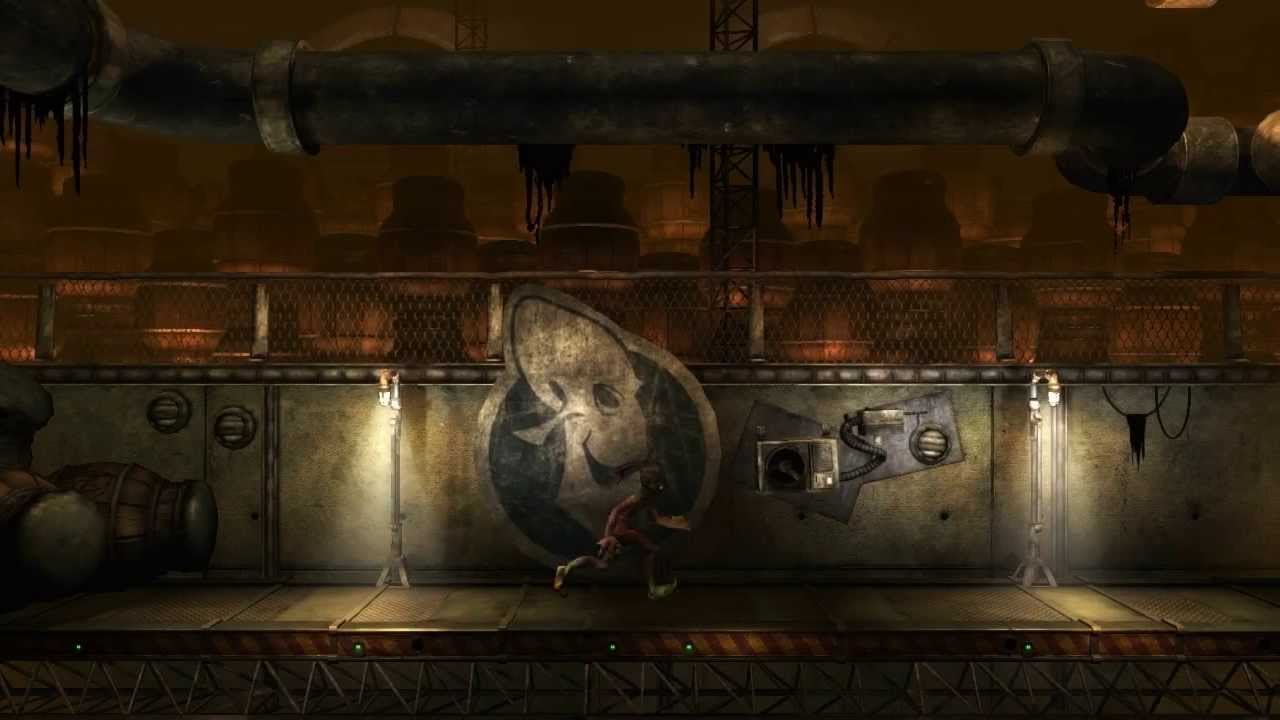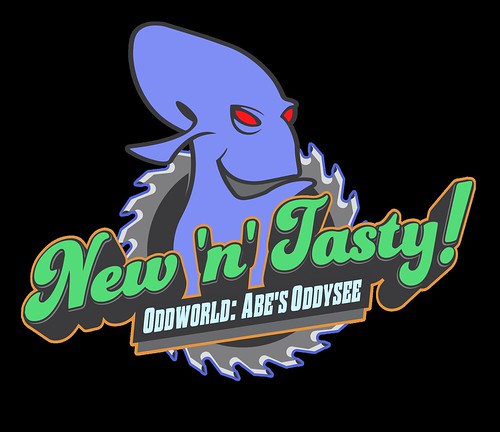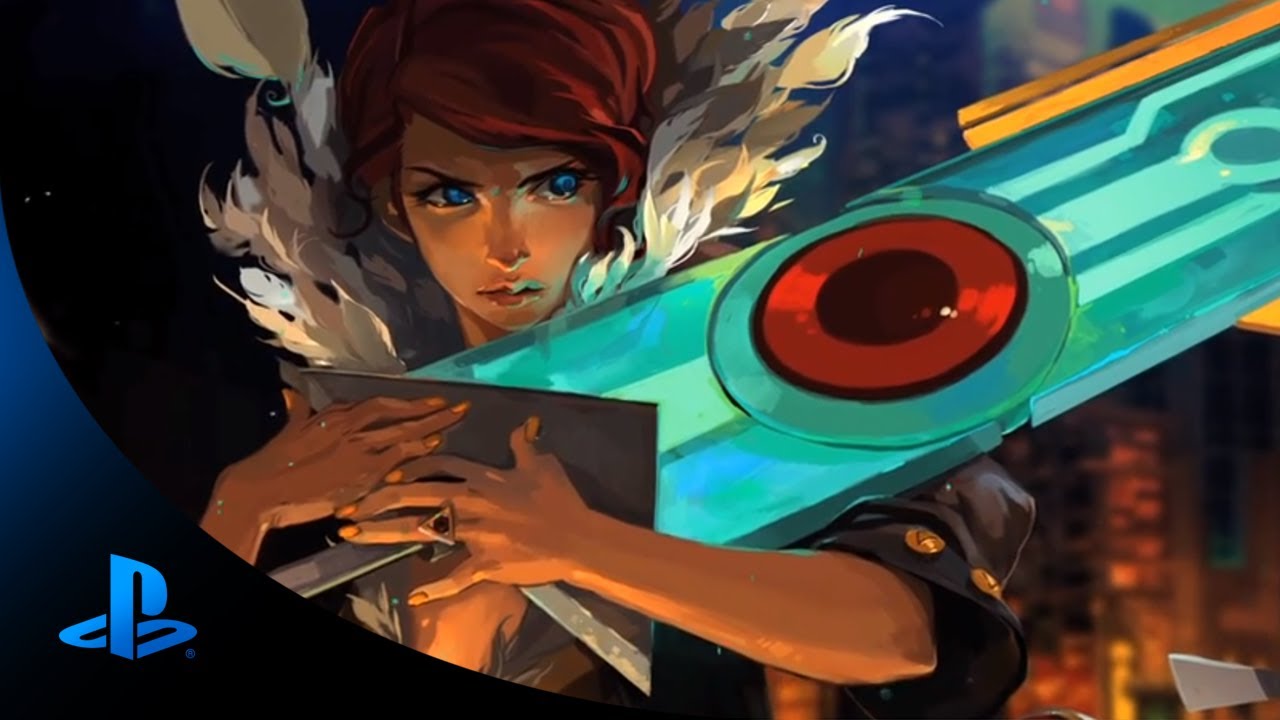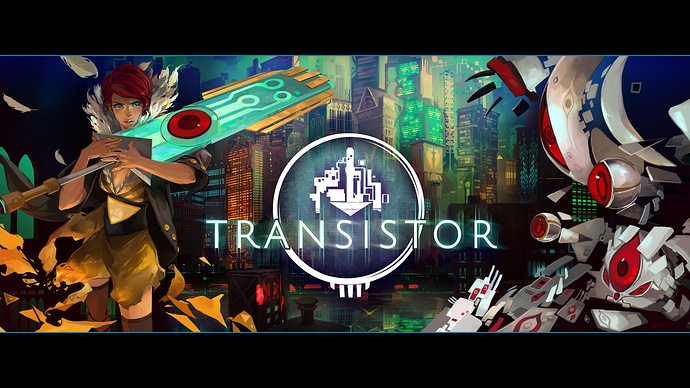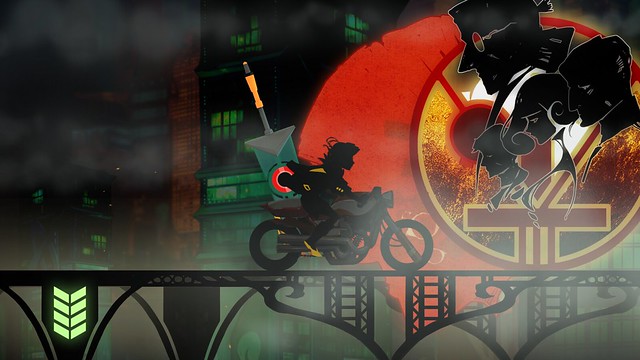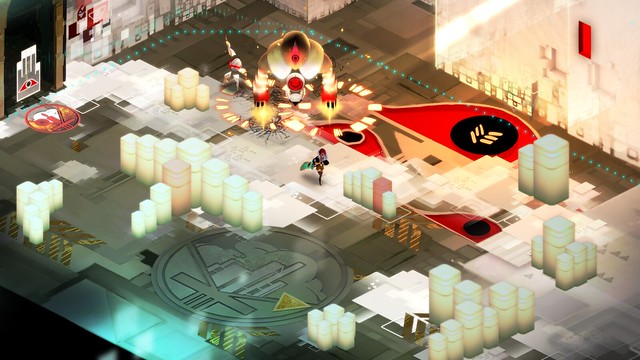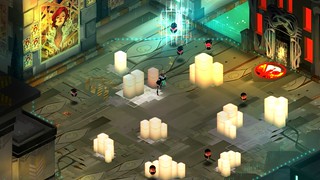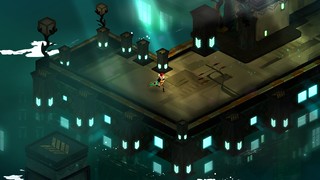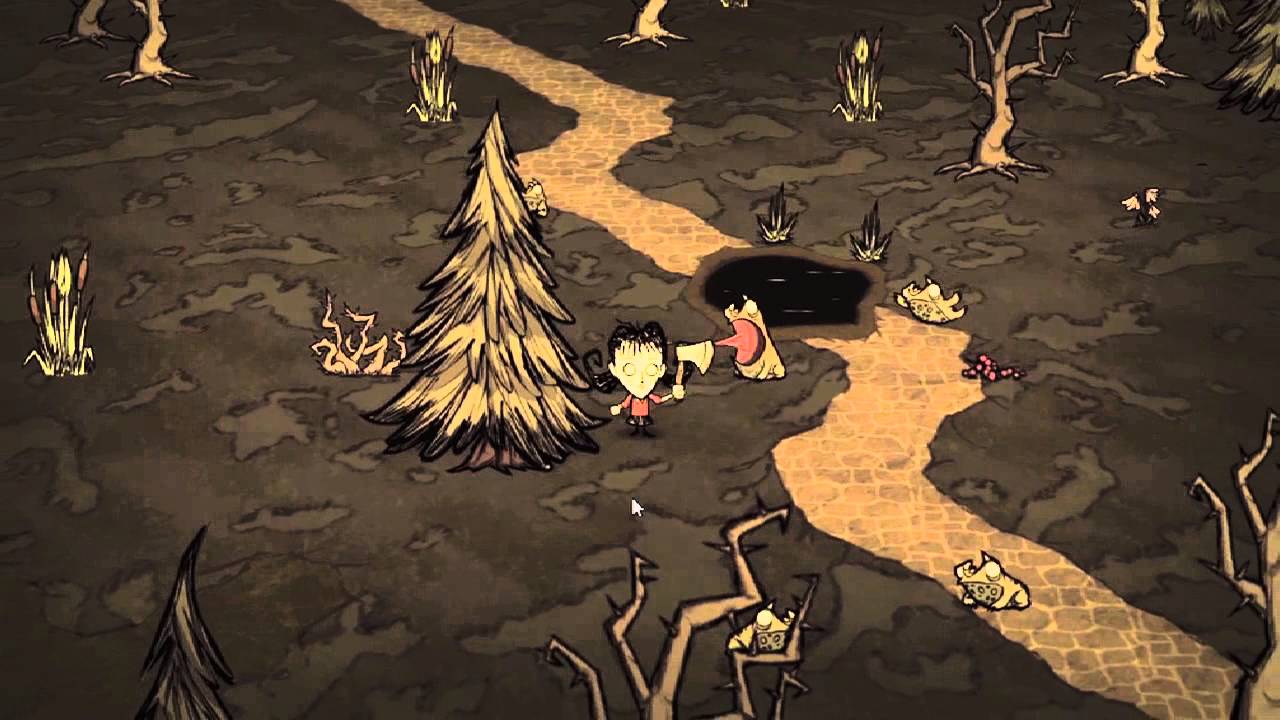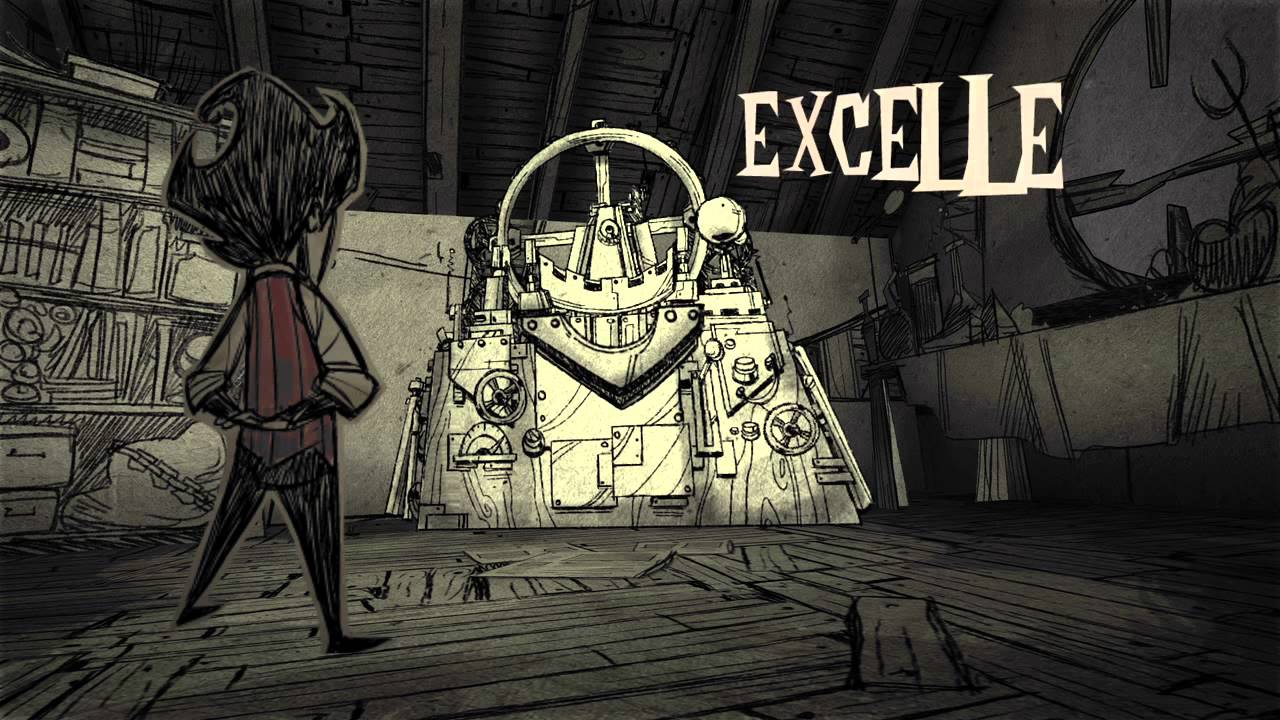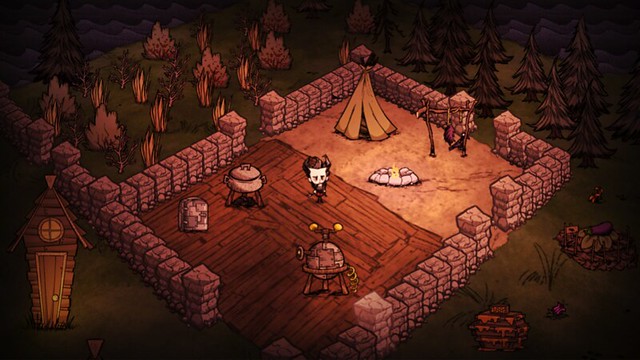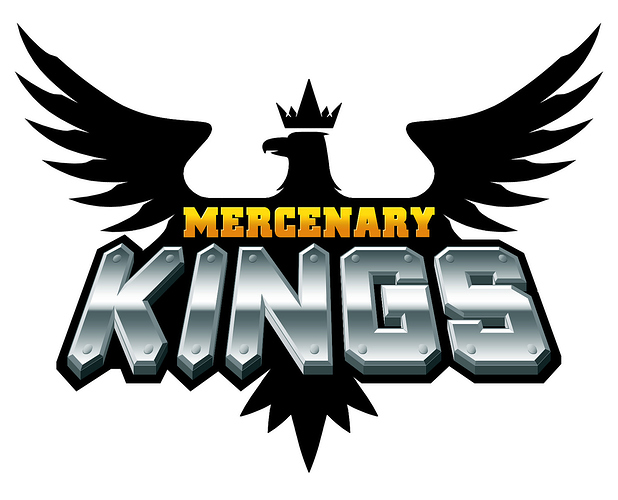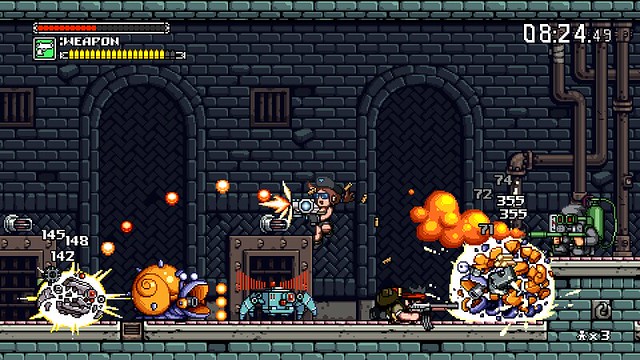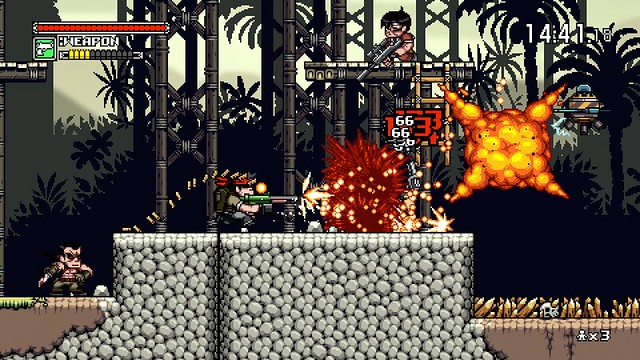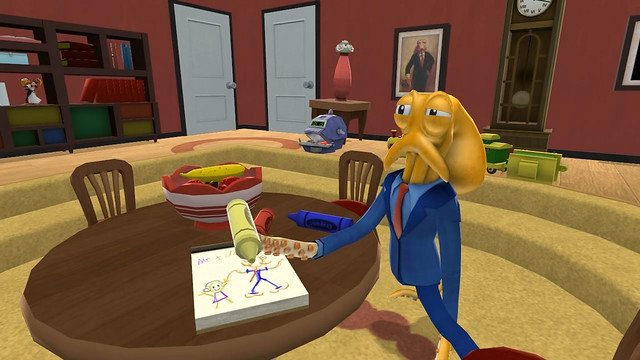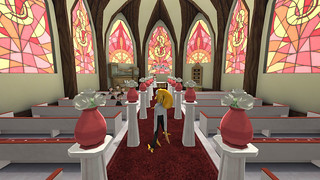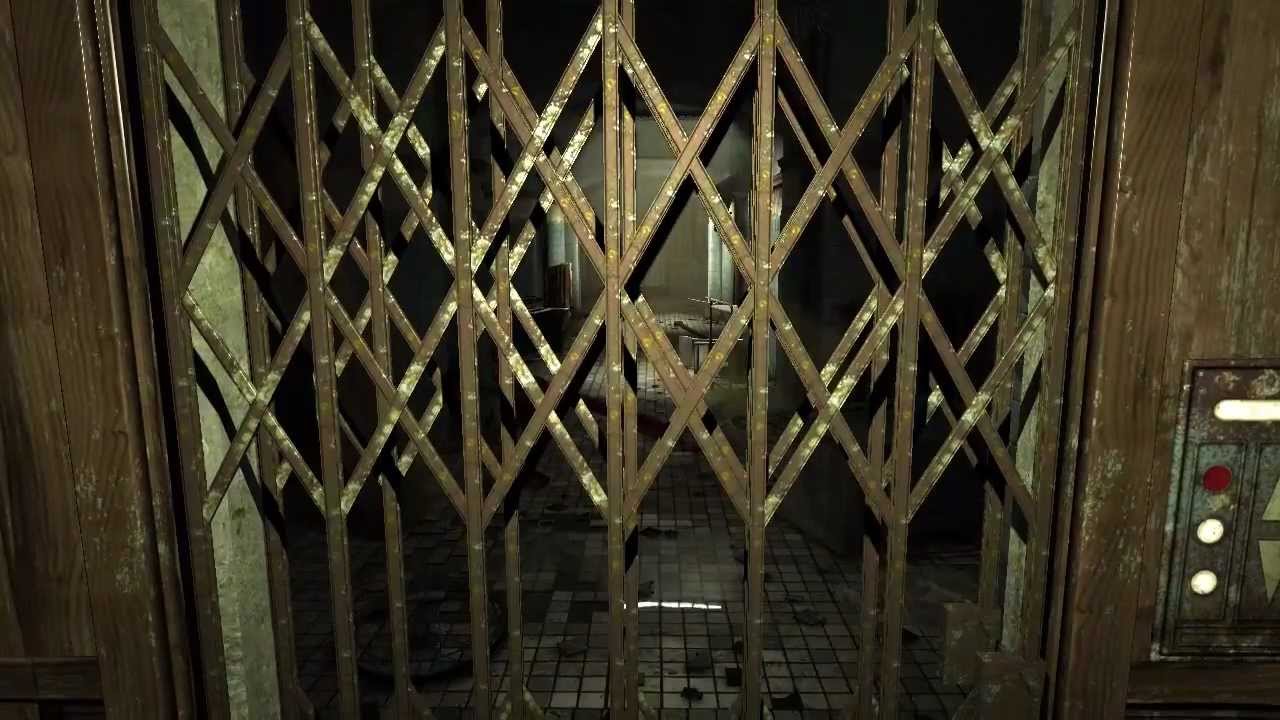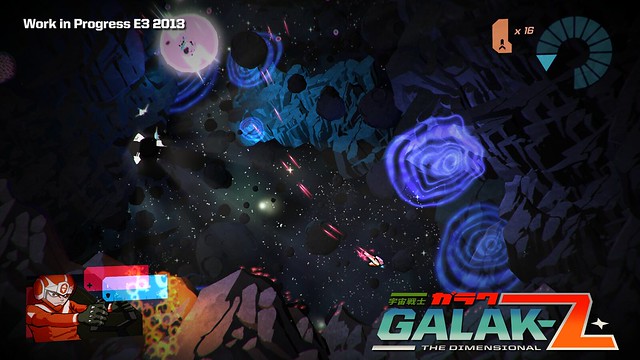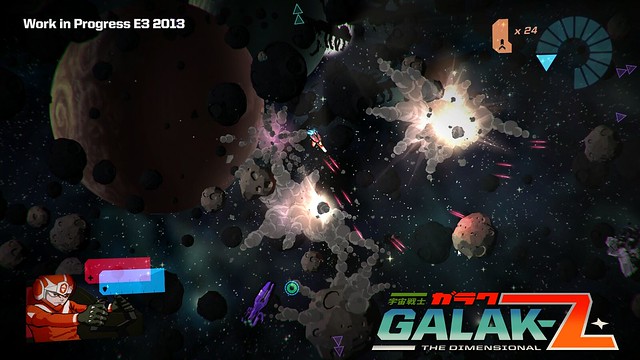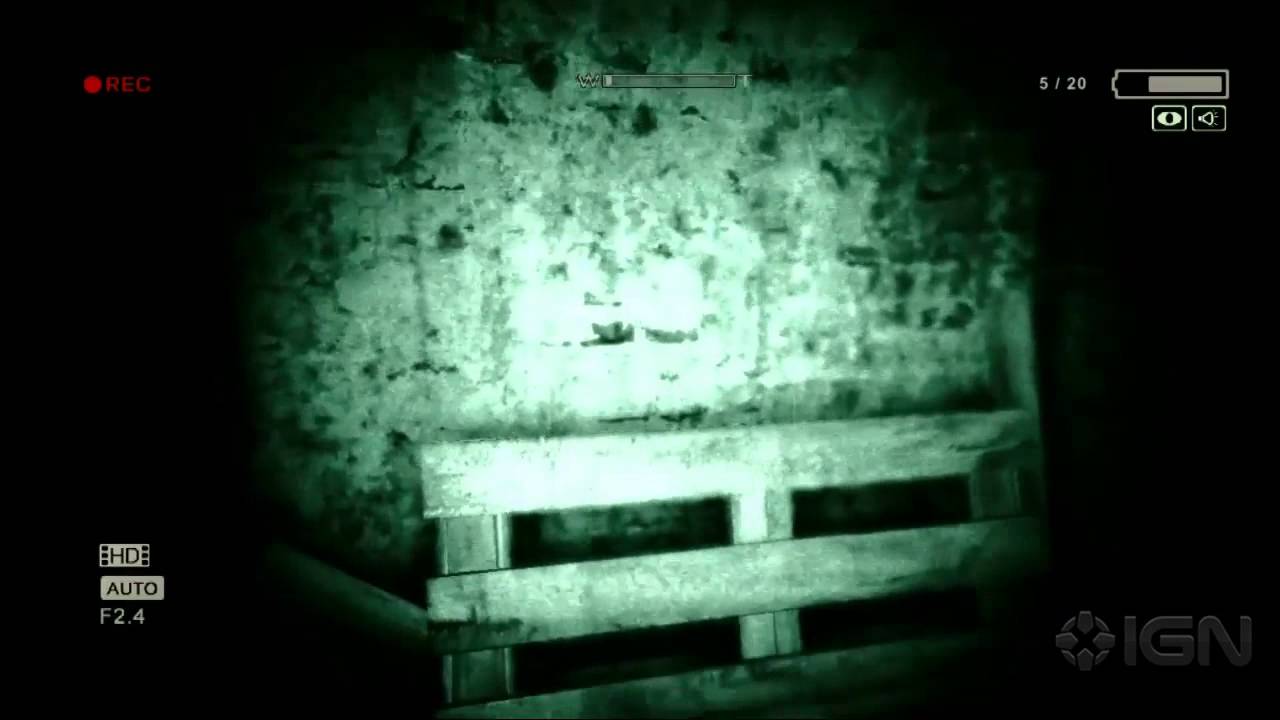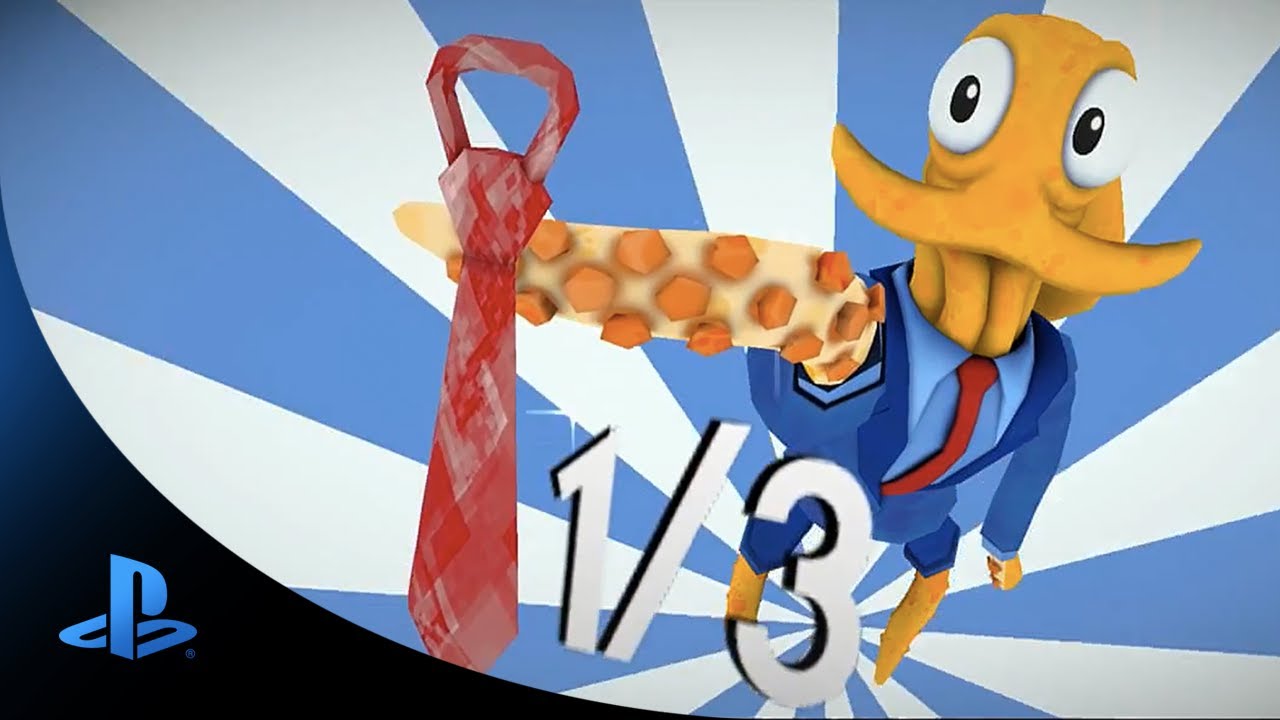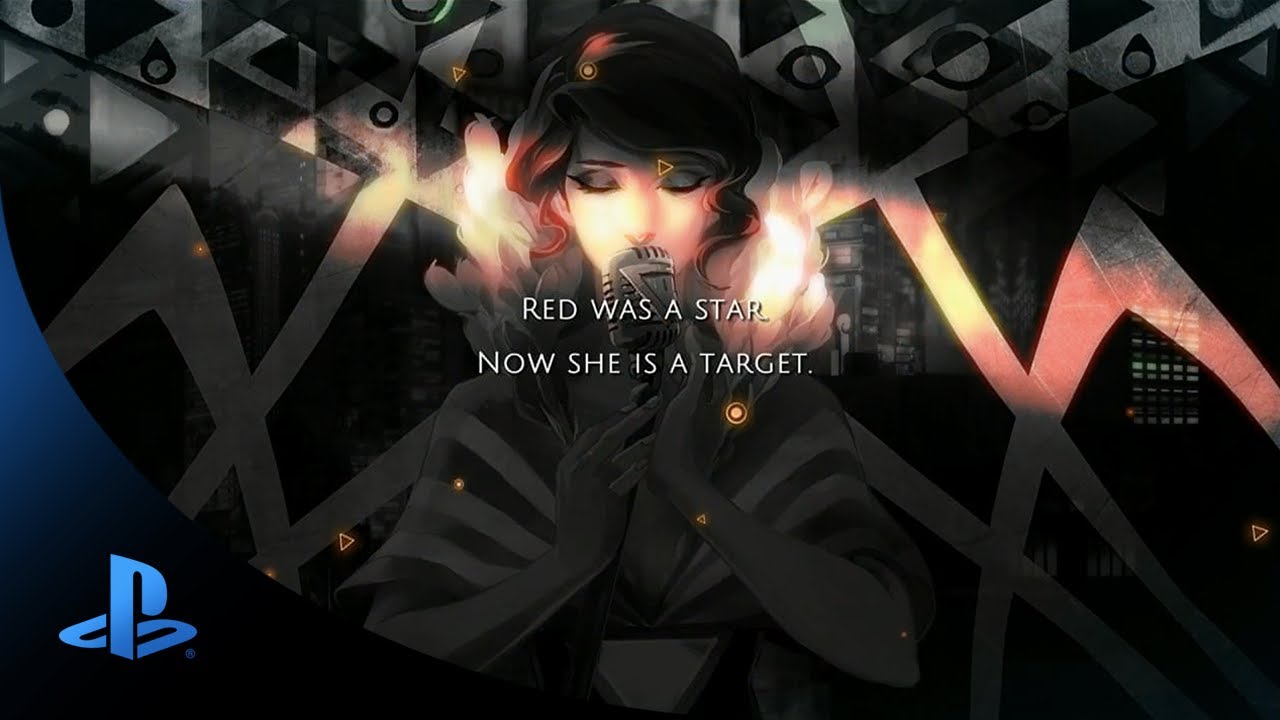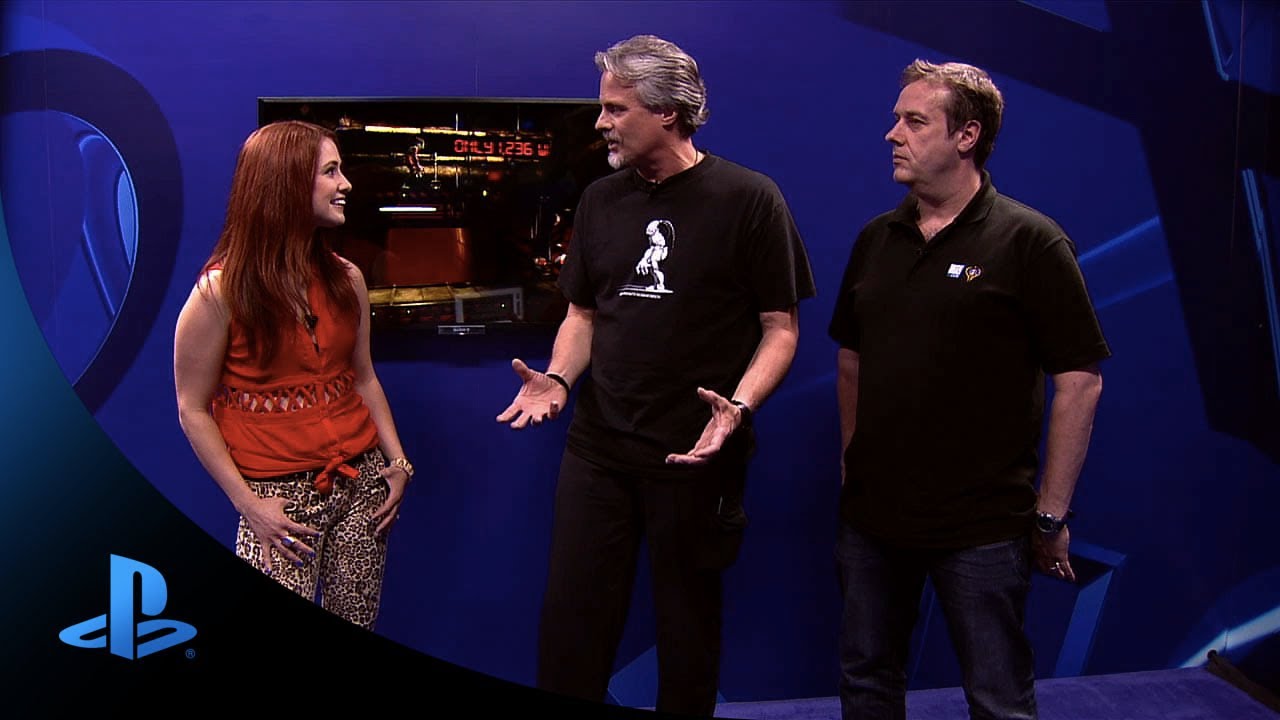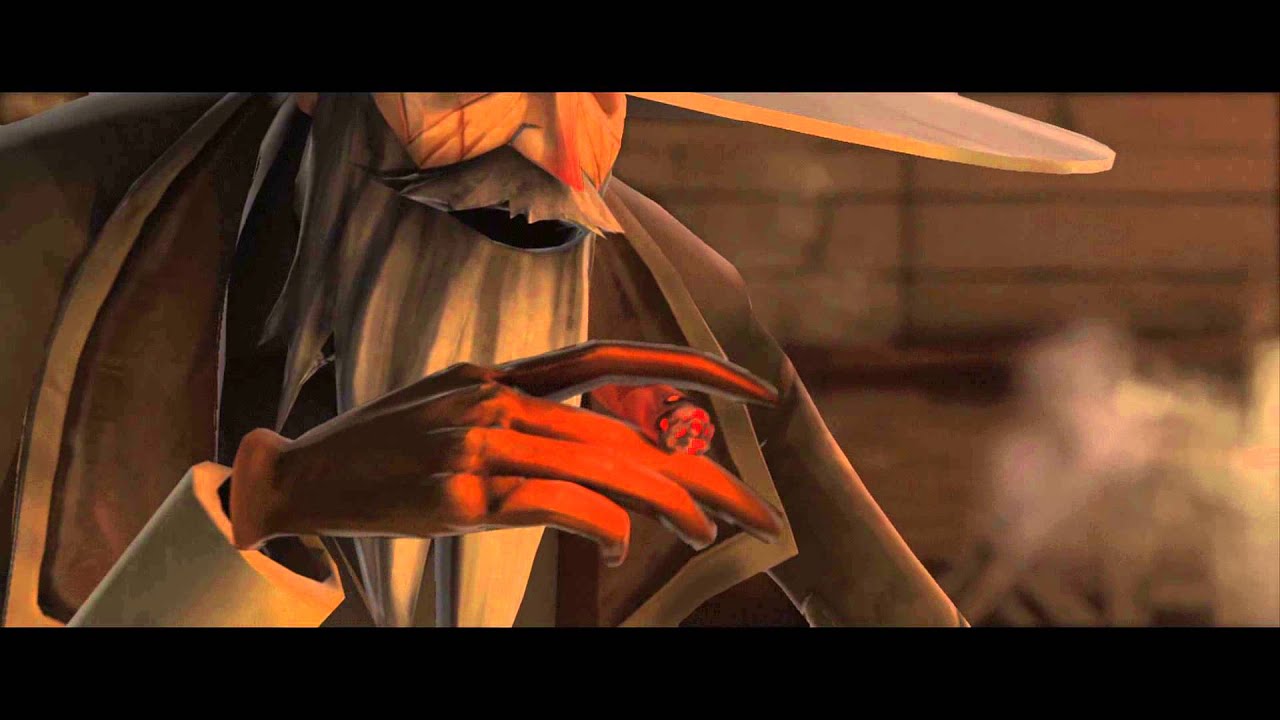“This… is RuptureFarms.”
Any fan of the original PlayStation remembers Oddworld: Abe’s Oddysee. The demo is famously found on the disc that came with your brand spanking new PSX, introducing an entire generation of gamers to the rich and twisted universe of the cinematic Oddworld games. Since then, we’ve seen Abe join a new friend in [URL=“https://store.sonyentertainmentnetwork.com/#%21/en-us/games/oddworld-munch”]Munch’s Oddysee, and resurface in the modern remake of Abe’s Oddysee, New ‘n’ Tasty, first shown off at Eurogamer Expo 2012.
We at Oddworld Inhabitants and [URL=“http://blog.us.playstation.com/tag/just-add-water/”]Just Add Water have been purposefully quiet about the game since [URL=“http://www.eurogamer.net/articles/2012-09-30-oddworld-abes-oddysee-new-n-tasty-revealed-at-eurogamer-expo”]Lorne and Stewart announced it. Our amazing team have been hard at work, and we’re ready to talk about it now…
We’re proud to announce that Oddworld: New ‘n’ Tasty will be launching on PlayStation 4, featuring all the gameplay you expect from the original, revamped, remade and reprocessed in the glorious Unity3D game engine. We’ve worked hard to bring you the Abe you know and love, kicking and screaming into 2013.
That’s right, Abe is truly coming home again. After a half-decade hiatus from making games, Oddworld Inhabitants is now a proudly independent micro-publisher, working with the hugely talented team at Just Add Water (Developments), Ltd. on the new title.
Abe first appeared back in 1997 as a 2D, pre-rendered platform game, featuring Hollywood quality video cutscenes and story. A lot has changed in the 15+ years since. PS4 is able to create lush, beautiful environments with ease, and we will make the most of that!
When we have such powerful tools to hand, you’ll be able to see the horror on Abe’s face as he lands in a new part of Rupture Farms. The world will come alive around you, revealing more uniquely Oddworld creatures, plants and details. Cutscenes have been beautifully remade and animated by previous Oddworld Inhabitants employees.
We’ve also re-examined all the levels. The original game featured flip-screen gameplay, whereby each level was broken down into single screens. Changing to a scrolling system, whereby the level is presented to the player as they moved, meant adapting some of the AI, level design and puzzles to better suit a seamless, dynamic and living Oddworld.
We know you’re all eager to get your hands on the game — so are we! Details about the release date, price and the chance to see more of the game will be released in the coming months.
Keep checking www.oddworld.com for more news, screenshots and videos. If you want to stay busy in the meantime, check out all the [URL=“https://store.sonyentertainmentnetwork.com/%23%21/search/f=%5Eoddworld%7Cbucket%7Egames”]Oddworld games on the PSN Store!
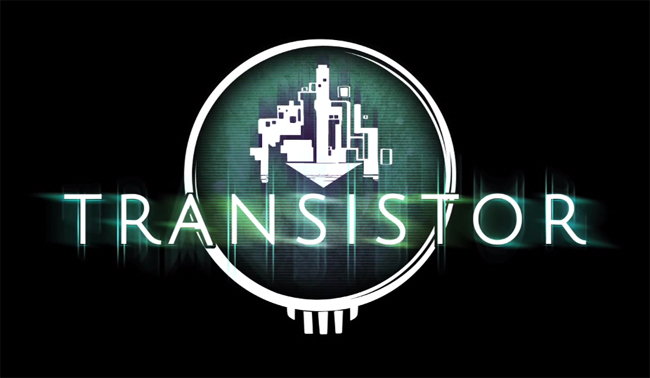
I remember when the seven of us at Supergiant were days away from revealing our first game, Bastion, back at PAX Prime in 2010. The game had been in development for about a year but we were only just figuring out how to talk about it to the public. When people would ask us “what is this game about,” what would we say? We weren’t sure at first, because Bastion is an action RPG where an old man talks to you the whole time — and that sounds really, really terrible. Thankfully, those who played it tended to come away with a much more positive impression. We eventually came up with stuff we could say about Bastion with a straight face, but by far our favorite way of presenting the game to people was to invite them to play it. Now here I am trying to tell you about our next game, [URL=“http://blog.us.playstation.com/tag/transistor/”]Transistor, and I wish I could just hand you a controller and let you try it for yourself. We revealed it earlier this year at PAX East, and today we’ve announced it will be making its console debut on the [URL=“http://blog.us.playstation.com/category/ps4/”]PlayStation 4 when we’re finished with it sometime early next year. If you check [URL=“http://www.youtube.com/watch?v=GTik6sYT_BE”]our reveal trailer, you’ll get a feel for what Transistor is like, though let me give you a little more background.
At Supergiant our games take inspiration from many of the most memorable games we played when we were kids. In my case it’s a very long list, everything from RPGs like the classic Ultima and Final Fantasy games, to fighting games like Street Fighter II and Samurai Shodown. Those games challenged my preconceptions of what games could be, and introduced me to unforgettable worlds and characters. Rather than throw back to the classics, though, we’re much more interested in capturing the experience of playing games like that for the first time. It’s that rush you feel when you find a game that’s incredibly novel but turns out to have a lot of depth there too… the kind of game you lose yourself in, and that leaves a lasting impression long after you’re done playing.
[URL=“http://www.flickr.com/photos/playstationblog/8974021910/”]
Bastion was our first attempt to act on this aspiration, and fortunately, it got a great response from around the world. It’s sold more than two million copies and earned more than 100 industry accolades, and put us in a position to maintain our independence, stick together as a team, and make something new. And, when it came to making something new, that’s exactly what we wanted. With Transistor, our aim is to create a unique-feeling game with its own strong, distinct identity, and many of its own surprises.
We’ve been working on Transistor for about a year and a half now, and most of the time has gone into finding that identity for the game. The result is a play experience that merges the kind of immediate moment-to-moment action we love with a much more deliberate and thoughtful strategic layer that lets you dictate the pace of a battle. We took inspiration from our favorite turn-based games and tactical RPGs, and aimed to capture the inherent drama and suspense of that style of play but in the context of an easy-to-learn action RPG. There’s nothing like turning the tables from the verge of defeat with some sort of spectacular last-ditch reversal, and the moment-to-moment play in Transistor should be packed with those kinds of opportunities. It’s all presented in a way that we think is unique to our game, and deeply connected to the story of this mysterious and powerful weapon you’ll be using throughout.
[URL=“http://www.flickr.com/photos/playstationblog/8974021988/”]
While I still sometimes struggle to find the words to describe the game I’m working on, I love talking about it almost as much as working on it, and I’d be happy to answer your questions right here in the coming days. In turn, if you want to know more about what we’re up to, please have a look at our web site or keep an eye on [URL=“http://twitter.com/supergiantgames/”]@SupergiantGames. In the mean time, we’ll keep doing our best to make a game that lives up to that Supergiant ideal.
Very recently, we decided to throw our lot into the PS4, and announced that Don’t Starve is coming on the platform. If you haven’t heard about [URL=“http://www.dontstarvegame.com”]Don’t Starve, it’s an uncompromising, wilderness survival game full of science and magic.
You play as Wilson, an intrepid Gentleman Scientist who has been trapped by a demon and transported to a mysterious wilderness world. Living in a randomly generated world, Wilson must learn to exploit his environment and its inhabitants if he ever hopes to escape.
Basically, you try not to die, but you will. A lot.
Don’t Starve was created to bend the rules of engagement. How do we build a game that focuses entirely on creating intrinsically rewarding gameplay? That is, rather than the game giving the player external (extrinsic) rewards, such as loot, levels, points and trophies, the fun part of the game is simply the experience and the challenge of playing it?
We wrote about intrinsic rewards early on in development, and the results were rather surprising. Over a period of 9 months, we worked with our community to develop and balance the game, updating Don’t Starve constantly. We’re now working hard to bring the experience to console, and if the logistics allow, we’d love to do the same on the PS4 once it’s launched.
Right now, our challenge is to implement a great interface for the PS4 controller. Some things, like movement and combat, are straightforward and arguably better on the controller than on the mouse, while others, like inventory management, are going to need some serious thought. We’ve already got a rudimentary system up, and it’s just great to be able to control Wilson on analog sticks.
Don’t Starve is a labor of love for our studio, inspiring us to create pieces like the following. Can you find the hidden message inside?
If you’d like to know more about our development, join us in our bustling community forums, or follow us [URL=“https://twitter.com/klei”]@klei. I’ll be posting here again as Don’t Starve for the PS4 develops. Later!
We’re really excited to tell you guys about the game we’re currently working on over at Tribute Games. [URL=“http://blog.us.playstation.com/tag/mercenary-kings/”]Mercenary Kings, coming to [URL=“https://us.playstation.com/ps4/”]PS4, is a 4-player co-op run and gun shooter with a compelling crafting system. Team up with up to 3 friends to take on an evil organization named CLAW.
What really makes Mercenary Kings stand out is the depth of its crafting system. While you’re on missions, defeating enemies and completing objectives will reward you with loot. This loot can be used to craft new gun parts and combine them to fit your play style! Want to put a shotgun barrel on that sniper rifle receiver? Why not!? Each gun is split up in five (receiver, magazine, stock, sight and barrel) with a selection of ammo types. We have over 300 gun parts already in the game so the possibilities are endless.
Enough rambling about customization. The game really starts to shine when you play with friends. A lot of people ask us why we went with split screen over forcing everyone in one screen. With our mission system, we quickly realized we wanted to give players the freedom to split up, and tackle various objectives separately and then possibly meet back up to take on the bigger main objective. Since our levels aren’t linear and bosses don’t necessarily always appear at the same spot, it’s a good idea to split up to find where the boss appeared this time and meet back up once found and take him down together!
Have you ever felt out of place? Just don’t feel you’re good enough, no matter how hard you try? Maybe you’ve got something to hide from the world. Maybe you’re not really the perfect human husband and father of three, but actually an octopus. This is what Octodad: Dadliest Catch is all about. You have a loving wife. You have adorable kids. They, however, have no idea of your secret cephalopod nature.
Octodad: Dadliest Catch is the first slapstick fatherhood simulator, and we’re excited to say that we’ll be bringing it to the [URL=“https://us.playstation.com/ps4/”]PlayStation 4 in 2014.
You may be asking yourself, “Well, what’s so difficult about being an octopus?”Well, first off, you’re an invertebrate, so you have no bones. Your body is gelatinous. As you can imagine, that makes it hard to simply move around outside of water. All those things we humans take for granted, like counteracting gravity, are a constant challenge. Oh, and you have eight arms you’ve managed to stuff into a fancy suit to form a human shape. There are hardships in Octodad’s life, to say the least.
The way Octodad: Dadliest Catch is played communicates this struggle through the control of Octodad’s body. Conquering the movement of this marionette made of jello is at the core of the game.
Each of Octodad’s limbs can be independently articulated in order to attempt to accomplish seemingly mundane tasks. Want to walk across the room? You get to control each wobbly step. Need to open a door? Navigate his tentacle…ahem…I mean arm to the knob and grab hold for dear life. It’s not easy to control a flopping ragdoll of a humanoid.
All of this comes together as an [in]elegant dance that often ends in the destruction of your surroundings. You’ll know when Octodad has been in a room: toppled bookshelves, broken dishes, flipped tables and every piece of furniture rearranged, as if by a bulldozer. All of this is accidental of course. You don’t like breaking things, do you?
[URL=“http://www.flickr.com/photos/playstationblog/8963460555/”]
While navigating the world, you must try not to be too conspicuous while others are watching, or do anything to draw suspicion from your family. If they find out that you’ve only been masquerading as a human, it’s game over. You love them, and it would be devastating to have them turn their backs on you for being the odd octopode out.
Octodad’s entire existence is a spectacle, and we hope that with the help of things like the sharing features of the PlayStation 4 you’ll be able to spread this insanity to your friends to brighten their day (or raise their awareness of the challenges of the octopus everyman).
If accidentally demolishing a kitchen while trying to grab a plate as a yellow flailing ragdoll makes you laugh as much as we still do after two years of development, we at Young Horses will have achieved all we’ve aspired to.
Make sure to leave any thoughts or questions below and we’ll answer them the best we can!
The Spaghetti Western is an inspiring genre brimming with attitude and style. From iconic character personalities and vivid settings, to tension-filled musical climaxes and boldly stylized visuals, every moment spent in a Spaghetti Western is filled with anticipation and epic drama.
At Switchblade Monkeys, we were inspired by this genre, and set out to make Secret Ponchos. We focused on 3 areas: creating original gameplay; setting a bold tone with the art and music; and shaping a player experience that feels true to the Spaghetti Western genre.
It seems like many first- and third-person shooters use similar gameplay mechanics to each other, and while we love those games, we knew we wanted to do something different with Secret Ponchos. We wanted to create an original gameplay style, one that felt as unique as the genre itself.
As it turns out, the keystone for this change was the camera. By placing the camera overhead, we discovered the game had its own unique feel for combat, because there were new types of information a player could draw from. Players could suddenly see who is where, how far they are, the environment in-between. The gameplay became about how you read and react to these situations in addition to the combat itself. We now had opportunities to create new mechanics. Among these, we studied fighting games and included elements of precision range mechanics as well as precision timing to give the game a responsive quick-twitch console control feel. The result is a combat style with a unique marriage of fighting games and team shooters. What’s especially cool is that even though it has fighting game aspects, it works for a wide range of player modes, including: intimate 1 vs 1 duels, 2-4 player gang fights, and guns-blazing 8-player free-for-all shootouts.
The art & music direction on Secret Ponchos was a real highlight for us to start developing. While there are other Western games, we found they tend to aim for a realistic feel. With Secret Ponchos, we wanted to push in a more stylized direction and go for more of a graphic comic book feel. Character shapes and attitudes were exaggerated. Dramatic poses and stylized animations brought the characters to life. Envision a mysterious character standing perfectly still, with his Poncho whipping in the dusty wind. Not to be outdone, the original scores were created to raise the epic feeling even higher. In Spaghetti Westerns, the music defines the mood, things become incredibly intense with ranges of tension building timpani rolls to epic trumpet melodies and crescendos of violence. Spaghetti Western music was the inspiration that started us to focus on this genre!
Lastly, the setting itself. The premise of the game is “What’s Your Head Worth?“. Players create an outlaw (a persistent character) and enter the town of Lonetree – where they instantly have a bounty on their head. Players then engage in battle against others, battles where one will stand and one will fall. Our bounty system fosters this mentality of kill-or-be-killed. If you win, the value on your head goes up, while the defeated outlaw’s bounty drops. As your notoriety and reputation increase, you can unlock perk points and upgrade your gameplay abilities, tweaking your properties in a way that suits how you want to fight. Something interesting that developed from this was the aspect of head hunting. When players gain fame and accomplishments, they also become larger, more valuable targets to take out. “What’s your head worth?” sets the player mentality in a space that we felt was a cohesive fit with the wild west.
With Secret Ponchos, we set out to create something unique, both in style and gameplay itself. We created and embraced a new type of cross-genre combat, and set the stage in a dramatic, highly stylized Spaghetti Western world that we hope people will love.
We’ve a very hands-on development team, and enjoy talking to people about the game and process. Please feel free to ask any of us questions and we’ll do our best to answer!
Hi, I’m Philippe Morin from Red Barrels! Together with co-founders David Chateauneuf and Hugo Dallaire, we started an indie studio for one reason: to use our experience working on games like Prince of Persia: The Sands of Time, Uncharted: Drake’s Fortune and Assassin’s Creed to make the horror game we’ve been talking about with each other for years. We’re all big horror fans, especially David, and the game we wanted to make, a realistic survival horror game, wasn’t the type of thing any big companies were willing to take a risk on. So we’re taking the risk ourselves with Outlast, a survival horror, stealth-based game set in an abandoned asylum, coming to PS4 next year!
The best games make you feel something, some type of emotion that sticks with you after you’re done playing. And fear is one of the most powerful emotions we can have as human beings. So for us, to make the best game possible, we know that we have to scare the s*** out of you. We’re trying to do that in a number of different ways, but where we start is with the design. In Outlast you play as a journalist with no weapons or fighting ability. You’re powerless and vulnerable: there’s actually a good reason to be afraid, because you can be hurt (or eviscerated). So, like in real life, your best option to survive is to run or hide. Using our past experience, we’re making those mechanics fun (but hopefully nerve-wracking!), giving your character some parkour-style moves and tweaking the AI so that enemies are smart about looking for you.
Design elements were the first step we took in order to terrify you, but we’re going farther. We partnered with a scientific consulting firm called Thwacke to get real-world data on mental illness and treatment techniques and make an authentic environment. Since Outlast is set in an asylum and your enemies are escaped mental patients, we felt it was important to portray our characters and setting in a realistic way, beyond just characters chasing you on a map. From the layout of the asylum to how enemies act, most of the game is based on real-world asylums. While we have some unexpected surprises waiting in the shadows, giving players as realistic a setting as possible makes the fear more tangible.
I mentioned before that we’re huge horror fans at Red Barrels. We spend hours watching classic and new movies and playing games like Amnesia – for fun and for inspiration. Immersing ourselves in horror has made it a little harder to sleep each night, but has also given us a lot of ideas. For instance, one of the things that makes a character like Jason or Michael Myers so frightening is their unstoppable drive – no matter what you do, they always keep coming to kill you. Outlast has a similar character, with some twists. More generally, what we’ve learned from countless hours trying to scare ourselves is that fear is all about setting expectations. When you start to walk up to a dark, Victorian building, you prepare yourself to be afraid; all that needs to happen after that is something to activate that fear, like a sudden movement or a creepy visual. Getting you into this state of expectation is something we care a lot about – as you can see from our PAX East booth design!
Fear is a weird thing. At PAX East, we had people coming out of our booth with many different reactions: some were giggling nervously, others were white and trembling, and others even came out joyfully discussing impaled corpses. We loved it; the different ways people express fear are really interesting to see, because each different reaction means that a person is having a personal, emotional experience with Outlast. Every designer wants their game to have an impact on how you feel, and we’re committed to making you feel as terrified as possible! Look out for more information about Outlast before our PS4 launch late next year.
What’s your favorite horror genre? Slasher, exorcism, clowns… tell me what scares you the most!
The very definition of “shooter” has changed greatly over the past decades – what once described classic 16-bit arcade space shooters now refers to modern first-person tactical combat shooters. We at 17-BIT want to merge the best of both worlds for an all-new type of adventure!
Classic arcades were once packed full of great spaceship shooters – they were the hottest genre around, with a million awesome variations from R-Type to Gradius to Pulstar. As time has progressed, there are still a handful of shmups on the market, but most of them take the classic form of wave after wave of unthinking enemies singlehandedly bent on flying by while trying to shoot you, as you navigate a field of projectiles – also known as “bullet hell.”
The modern shooter has many more tactical options – through the power of modern AI, you can fight entities that are almost as crafty and cunning as real human opponents: enemies disengage from combat to allow their shields to recharge, call for backup, and provide covering fire for their teammates. We wanted to bring this same level of challenge from the very latest high budget-shooters back into a 2D spaceship world, for an all-new type of experience inspired by these two classic genres.
I really like Far Cry 3 – so here’s how it relates to our game. The enemies in Far Cry 3 have vision cones, and can hear you if you are scuffling around too close to them. There are various types of cover you can use to avoid detection, but if you’re spotted, they’ll shout out your location. This leads to tactical planning, and trying not to be caught in the open by too many enemies; you choose how to engage, losing line of sight to briefly heal and recharge, and head back out into a finely honed tactical combat moment. That’s exactly the kind of experience we’re bringing to GALAK-Z. These enemies prioritize not dying over serving as bullet fodder, and support each other through covering fire and calling for backup.
Our enemies are out on patrol, so you’re never fully sure where you’ll find opportunities to engage. We have massive cave systems, and elements of the amazing Metroidvania style of gameplay, married to very brutal, physics-based, cutting-edge dogfighting combat. Without having to fight a 3D camera, the player-to-game connection is a perfect zen-like bliss state of combat!
We really wanted to do something visually firmly rooted in the classic sci-fi anime worlds of the late ‘70s and early ‘80s. Classic, genre-defining anime like Starblazers/Yamato, Robotech/Macross and Gundam defined my childhood, as well as classic spaceship arcade shooters of the time, and GALAK-Z is being designed to take as many visual cues from this era as possible. It’s a fun world with great characters that we look forward to sharing with everyone soon!
We have all this power, how do we push it to the maximum? At first glance it’s “just” a 2D spaceship shooter, so where is all the power of the PS4 being harnessed? Most objects in the world have physics, so crashing into asteroids will send them flying out of your way. Enemies explode and slam into each other. A sentinel’s sword swipe can send you flying into a dangerous bunch of living cave spikes. This is a world full of mass, weight, timing, and all kinds of great new combat encounters. With all this horsepower we are able to do almost every effect as a massive particle system featuring hand-drawn sprites, resulting in a beautiful hand-drawn look that is being procedurally generated every time you shoot a laser, explode an enemy or blast your way through an asteroid field!
This game has been a long time coming, since we’ve wanted to play in this space (no pun intended) for a very long time. The classic spaceship 2D shooter is rarely revisited with modern tech and gameplay innovations, and it turns out it’s a fantastic formula, combining great elements from modern gaming and classic gaming for a phenomenal, organic combat-adventure experience.
